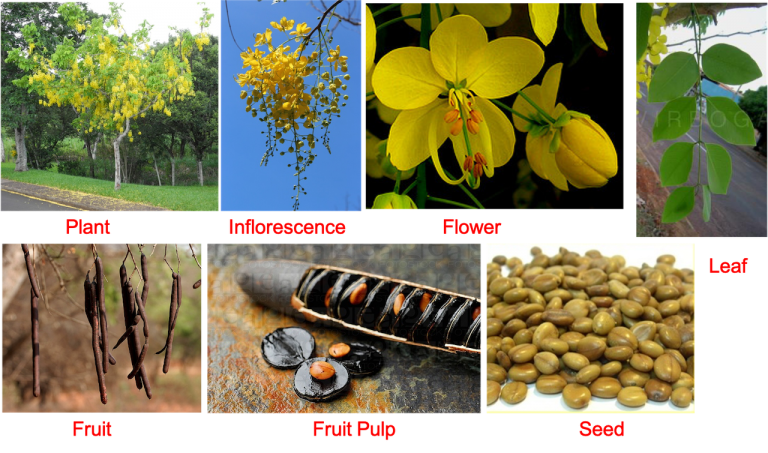ARAGWADHA
- Home / DRAVYAGUNA (AYURVEDIC PHARMACOLOGY) / / KNOW ABOUT MEDICINAL PLANTS / / AYURVEDIC MEDICINAL PLANTS /
- ARAGWADHA
The plant Aragwadha is a very well known plant especially in the state of Kerala for its flowers which blooms in the month of April. It is this time that the festival of VISHU is celebrated by the people of the state. The plant is the most beautiful one to see during its full bloom and hence has the synonym as RAJAVRIKSHA. Medicinally, this plant was well known right from the ancient times. It mention in the Charaka Samhita in different formulations is a standing example of its medicinal use. Botanically this plant is known as Cassia fistula Linn. The word Cassia is derived from the the greek name to the plant Kasia while the word fistula means something that is reed, tube or pipe like which is how the fruit of the plant looks. The plant is seen throughout India and similar regions upto an altitude of 1500mts
PLANT DETAILS
BOTANICAL NAME
Cassia fistula Linn
FAMILY
Caesalpiniaceae
NOMENCLATURE
VERNACULAR NAMES
- Kannada – Kakkikayi
- Malayalam – Kanikonna
- Tamil – Appai
- Telugu – Kolaponna
- Hindi – Amaltas
- English – Purging Cassia, Pudding pipe
SANSKRIT SYNONYMS
- आरोग्यशिम्बी (Arogyashimbi) – Legume that protects health.
- स्वर्णक (Suvarnaka) – The tree looks like cladded with gold when blossom
- आरग्वध (Aragwadha) – That which relieves the diseases
- राजवृक्ष (Rajavriksha) – A majestic tree like a king
- शम्पाक (Shampaka) – The plant is auspicious
- चतुरङ्गुल (Chaturangula) – The parts of the plant namely the leaf and fruit have 4 Angula (Finger) length.
- आरेवत (Arevata) – Grows in mountainous region.
- व्याधिघात (Vyadhighata) – Relieves the diseases effectively.
- कृतमाल (Kritamala) – The flowers are arranged like a garland.
- कर्णिकार (Karnikara) – Appears like ear-rings or ear hangings.
- दीर्घफल (Deerghaphala) – Large sized fruit or long fruit
- स्वर्णाङ्ग (Swarnanga) – The tree looks to be golden when the flower blooms
- स्वर्णभूषण (Swarnabhushana) – The tree appears to be decorated with golden ornaments when blossom.
SAMHITA CLASSIFICATION
- Charaka Samhita – कुष्ठघ्न (Kushtghna), कण्डुघ्न (Kandughna), विरेचन (Virechana) and तिक्तस्कन्ध (Tiktaskanda).
- Sushruta Samhita – आरग्वधादि (Aragwadhadi), श्यामादि (Shyamadi) and अधोभागहर (Adhobhagahara)
NIGHANTU CLASSIFICATION
- Dhanvantari Nighantu – Guduchyadi Varga
- Bhavaprakasha Nighantu – Hareetakyadi Varga
- Raja Nighantu – Prabhadradi Varga
- Kaiyadeva Nighantu – Aushadhi Varga
BRIEF MORPHOLOGY
A medium sized deciduous tree, that grows upto 9 meters height. It grows straight with smooth and pale grey bark when young which becomes rough and dark brown on maturity. It has spreading branches that are slender. The leaves compound, 23-40cms in length, pubescent, minute stipules. Leaflets are 4-8 pairs, paripinnate, ovate, bright green and glabrous above while paler and silvery pubescent beneath. Inflorescence is Lax pendulous racemes that are 30-50cms long. The flowers are yellow in colour, 5 petals, bisexual. Fruits are pods 30-60cms long and around 2.5cms in diameter, pendulous, cylindric, smooth, dark brown with 40-100 seeds immersed in dark coloured pulp separated by a transverse dissepiments. The seeds are ovate and is 5mm thick.
The fruit pulp is obtained from the ripe fruits which is kept in sand for 30 days. The pods are then taken and dried in sunlight. Then the pulp from the pods are taken out into the clean vessel. The pulp should be removed by using a cold or warm water. If the fruits are old then the pods are heated a little so that the pulp is obtained easily.
PHARMACOGNOSY OF OFFICIAL PART
MACROSCOPY
YET TO BE COMPILED
MICROSCOPY
YET TO BE COMPILED
PART USED AND POSOLOGY
PART USED
फलमज्ज (Fruits or Pods pulp), पत्र (Leaves), मूल (Roots), त्वक् (Bark) & पुष्प (Flowers)
DOSE
फलमज्ज (Fruit Pulp) – 2 to 5 gms क्वाथ (Decoction) – 10-15ml.
PHYTOCHEMISTRY
The plant is rich in anthraquinones, flavanoids, alkaloids, glycosides, tanins, steroids, saponin, terpenoids and reducing sugars. The laxative actions which is supposed to be the main activity of the fruit pulp is attributed to the anthraquinones. The elaves contain little amount of tannin and anthraquinones. The root bark has tannin, oxyantrhaquione and phlobaphenes. The pulp of the fruit also constains pectin, glutine, calcium oxalate, etc.
रसपञ्चक कर्म PROPERTIES AND USES AS PER AYURVEDA
गुण (Properties)
- रस (Rasa) – मधुर (Madhura), तिक्त (Tikta)
- गुण (Guna) – गुरु (Guru), मृदु (Mrudu), स्निग्ध (Snigdha)
- वीर्य (Veerya) – शीत (Sheeta)
- विपाक (Vipaka) – मधुर (Madhura)
- प्रभाव – अधोभागहर (Adhobhagahara)
कर्म & प्रयोग (Action & Indications)
- दोषकर्म (Doshakarma) – वातपितताहरा (Vatapittahara) पित्तकफसंशोधन (Pittakaphasamshodhana)
- धातुकर्म & मलकर्म (Dhatukarma and Malakarma) – Main actions – स्रंसन, मृदुरेचन, दाहहर, शूलप्रशमन, अनुलोमक,(Sramsana, Mridurechana, Dahahara, Shulprashamana, Anulomaka)
- Other Actions – कुष्ठघ्न, कण्डुघ्न, यकृदुत्तेजक, हृद्य, आमपाचक, ज्वरघ्न (Kushtaghna, Kandughna, Yakrituttejaka, Hridya, Amapachaka, Jwaraghna)
- प्रयोग (Prayoga) – Mainly ज्वर, गुल्म, उदर,शूल, उदावर्त, हृद्रोग, व्रण, प्रमेह (Jwara, Gulma, Udara, Shula, Udavarta, Hridroga, Vrana, Prameha) also useful in रक्तपित्त, कुष्ठ, कण्डु, विसर्प, शोथ, उपदंश, शीतपित्त, etc (Raktapitta, Kushta, Kandu, Visarpa, Shotha, Upadamsha, Sheetapitta, etc)
AYURVEDIC FORMULATIONS
CLASSICAL
- आरग्वधादि लेह
- आरग्वधादि तैल
- आरग्वधारिष्ट
- कुष्ठराक्षस तैल
- महारास्नादि क्वाथ
- 12 Formulations of the plant mentioned in Charaka Samhita Kalpasthana 8th Chapter
PROPRIETARY
- Aragwadha Kapila vati
- Vedic Aragwadha Powder
- Zyrex Aragwadha Tablet
AGRONOMY
ENVIRONMENT
It can grow in variety of environment at lower altitudes upto an altitude of 4000 feet above sea level. It can tolerate dry soils, slopes, etc ranging from acidic pH of 5.5 to alkaline pH of 8.7. It thrives in volcanic, laterite, granite & sandstone soils. But can also grow in sandy loamy soils. It also withstands or requires 500 to 3000mm of rainfall and withstand a temperature range of 7 deg C to 43 deg C.
CULTIVATION
The plant can be propagated by seeds, cuttings or even layering. Seeds have a hard coat and hence the viability is present even after long period of storage. The seeds are put directly on soil especially in Asia. If the seed is kept in container then the seedling will need 2-3yrs for being suitable for planting. During planting the soil should be moist with high humidity. It may require 8-9years for first flowering and pod formation. Can be quickened by vegetative propagation. Around 400 plants can be planted in 1 acre
HARVESTING
The plant usually flowers in the month of March and April and fruiting in the month of May and June. The yield is around 40 to 110 seeds in each pod.
STORAGE
The pulp is scraped from the pods while the pods for trade are dried. The pods are also kept in heap of sand and the pulp is collected. Direct is avoided as it may loose purgative causing constituents.
VARIETIES AND SUBSTITUTES OR ADULTERANTS
VARIETIES
NO VARIETIES
ADULTERANTS
NO KNOWN ADULTERANTS
SUBSTITUTES
NO KNOWN SUBSTITUTES
TOXICITY
TOXIC SYMPTOMS
- As such there is no proved toxicity of the plant.
ANTIDOTE
- Not Applicable as such.
शोधन or PURIFICATION METHOD
- NOT NECESSARY
THERAPEUTIC USES
EXTERNAL USES –
The fruit pulp and leaf paste is applied in conditions like Amavata or Rheumatoid Arthritis, gouty arthritis, etc painful conditions and oedema. The decoction of the bark is used as a gargle to treat diseases of the oral cavity. To treat skin diseases, application or Lepa is done with the paste of the leaf.
INTERNAL USES –
Internally the fruit pulp is given as a laxative and is used in the conditions where the procedure of Virechana is indicated. The seed powder is used to treat Amoebiasis. The pulp is mixed with milk, sugar, etc adjuvants and given to drink to treat constipation and even in jaundice as a laxative.
CONTROVERSY (IF PRESENT)
YET TO BE COMPILED
LIST OF RESEARCH STUDIES
- Ali MA: Cassia fistula Linn: A review of phytochemical and pharmacological studies. Int J Pharm Sci Res 2014; 5(6): 2125- 30.doi: 10.13040/IJPSR.0975-8232.5(6).2125-30
- Chauhan, . P., Tiwari , R. C., Bhutiani, R., & Ahamad, F. (2019). Study of Aragvadha (Cassia fistula Linn.) with special reference to phyto-pharmacological properties: An overview. Environment Conservation Journal, 20(1&2), 133-138. https://doi.org/10.36953/ECJ.2019.1008.1219
- Pavan Kumar S, Muralikrishna C, et.al (201o). Medicinal properties of Aragvadha (Cassia fistula Linn.). International Journal of Ayurvedic Medicine, 1(3), 129-133.
- Heuzé V., Thiollet H., Tran G., Hassoun P., Lebas F., 2018. Golden tree (Cassia fistula). Feedipedia, a programme by INRAE, CIRAD, AFZ and FAO. https://www.feedipedia.org/node/325 Last updated on April 23, 2018, 10:54
The video on Aragwadha emphasises on the various aspects of the plant especially with respect to its cultivation and its characteristics for identification such that they are preserved for the future generations.



